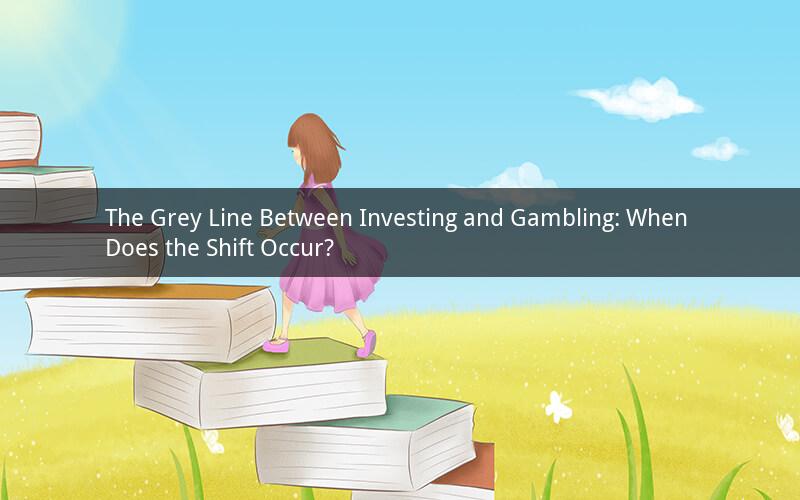
Investing and gambling are two distinct concepts that share some similarities but have crucial differences. Many people often wonder where the line between these two practices truly lies. This article delves into the intricacies of this debate, exploring the factors that contribute to the blurred boundaries and discussing the scenarios where investing might cross over into gambling.
Investing involves purchasing assets, such as stocks, bonds, or real estate, with the expectation of generating returns over a period of time. The key to successful investing is research, due diligence, and the ability to assess the risks and rewards associated with each investment opportunity. On the other hand, gambling is a form of risking money on an uncertain outcome, with no real expectation of generating returns. The key difference is the presence of an element of chance, where the outcome is determined by luck rather than skill.
Determining the point at which investing becomes gambling is a complex matter. This article aims to shed light on the various factors that may contribute to this shift and provide some guidance on how to avoid falling into the gambling trap.
1. Lack of Research and Due Diligence
Investing is all about making informed decisions based on thorough research and analysis. When an investor fails to perform due diligence and instead relies on luck or hearsay, the line between investing and gambling starts to blur. This scenario is particularly common among retail investors who invest in companies they know little about or follow trendy stocks without considering their financial health and market prospects.
2. Emotion-Based Decisions
Investing requires a rational mindset and the ability to stay disciplined, especially during market downturns. When investors allow emotions, such as fear or greed, to influence their investment decisions, they are more likely to take excessive risks or exit the market prematurely, akin to a gambler. Emotional decision-making is a significant factor in transforming investing into gambling.
3. Speculative Investing
Investing in speculative assets, such as highly volatile cryptocurrencies or speculative stocks, can be seen as a form of gambling. While some speculative investments can offer substantial returns, the risk of losing the entire investment is high. This type of investing is often driven by the allure of quick profits rather than a long-term strategy.
4. Short-Term Focus
Investors who prioritize short-term gains over long-term returns are more prone to gambling-like behavior. This approach often involves trading frequently and taking on high-risk positions, which can lead to significant losses over time. When the primary goal is to make quick money, investing starts to resemble gambling.
5. Inadequate Risk Management
Risk management is a fundamental aspect of investing. When investors ignore risk or fail to implement proper risk management strategies, they may end up engaging in gambling-like behavior. This is especially true in leveraged investing, where borrowed capital is used to amplify potential returns but also magnify potential losses.
In conclusion, the distinction between investing and gambling lies in the level of research, due diligence, risk management, and long-term perspective an investor employs. By adhering to a disciplined investment strategy, investors can avoid the gambling trap and maximize their chances of achieving sustainable returns.
Here are five questions related to the topic:
1. What are the primary differences between investing and gambling?
Answer: The primary differences lie in the presence of an element of chance in gambling and the focus on long-term returns in investing. Investing involves thorough research, risk management, and a disciplined approach, while gambling is driven by luck and often lacks a well-defined strategy.
2. Can an investment always be considered gambling?
Answer: No, an investment can still be considered an investment even if it involves some degree of risk or uncertainty. However, if an investor engages in speculative investing, emotional decision-making, or lacks proper risk management, the line between investing and gambling may start to blur.
3. How can investors avoid the gambling trap?
Answer: Investors can avoid the gambling trap by focusing on long-term goals, conducting thorough research, maintaining discipline, implementing proper risk management strategies, and avoiding speculative investments or emotional decisions.
4. Are all high-risk investments considered gambling?
Answer: Not necessarily. High-risk investments can still be considered investments if they are part of a well-thought-out and diversified investment strategy. The key is to understand the risks and potential returns associated with these investments and ensure they align with the investor's long-term objectives.
5. Can a person be both an investor and a gambler?
Answer: Yes, a person can engage in both investing and gambling. However, it is essential to recognize the differences between the two practices and ensure that their investing activities align with a well-defined investment strategy and long-term goals. Balancing investment and gambling behaviors can be challenging, as it requires a disciplined approach and a strong understanding of risk.